Unfortunately some numbers of this multi have gone missing. You will find the numbers in the "hint". We would still recommend you going to these places as they are really worthwile visiting.
WELCOME to our guided tour of Bath City!
We would like, if we may, to take you on a journey to twenty must-see popular sights of Bath. This multi-staged cache consists of an approximate 3 mile walk around the Georgian City of Bath. It is not a quick cache-and-dash but you can pick up some excellent Bath caches en route.
We believe that most of the terrain is suitable for buggies and wheelchairs, however, the last few metres of the tour are not. Due to the distance and because of some uphill/downhill areas we've chosen the T-rating of 2.5.
It may be possible to research some answers beforehand but to get to know the city, we recommend looking at these famous sights and finding out the answers as you go.
Ev1l 81tch has placed five great Adventure lab caches in the city centre of Bath. You can find the answers to these lab caches whilst doing this multi. After having found the five adventure lab caches, there is also a great Bonus Cache to these lab adventures.
Please let us know if there are any issues associated with this round or if you've got any suggestions for improvement.
If you are struggling to find any of the clues, have a look at the photos of Eeyore; these photos are generally taken near where you can find the answers to the questions.
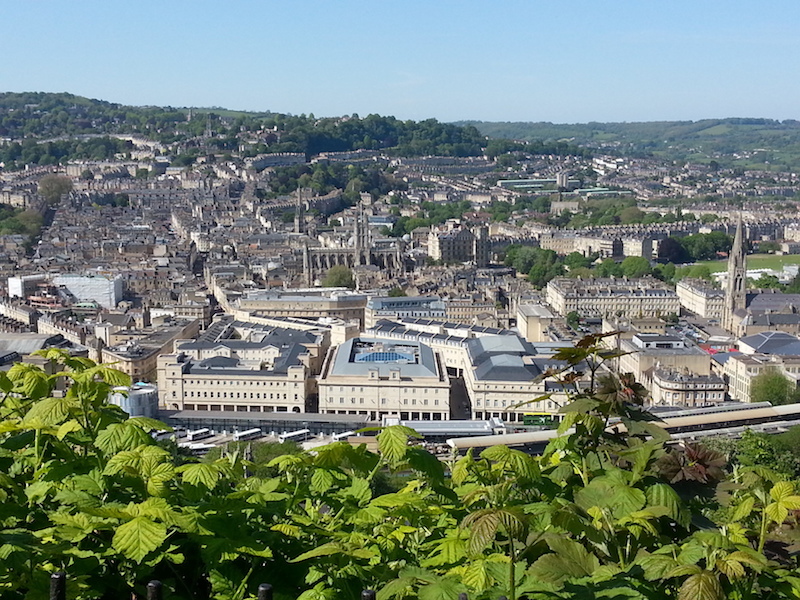
Views of the City of Bath
STAGE 1: The Roman Baths
|
We start our tour at the back of the Roman Baths. The entrance to the Roman Baths is at Stage 2 of our walk, just beside the entrance to the Pump Room. For centuries, hot spa water has been bubbling up from the grounds in Bath. When the Romans invaded Britain in 43 AD, they found that the Celts had built a shrine at this site and had dedicated the hot springs to their goddess Sulis. The Romans identified Sulis as their goddess Minerva and built a temple at the same site between 60 and 70 AD, which they then dedicated to Minerva. At the temple, Romans had baths in the caldarium (hot bath), tepidarium (lukewarm bath) and frigidarium (cold bath). After the Romans left Britain, the baths fell into disrepair and were destroyed by the 6th century. In the 1870s, the Roman Baths were rediscovered, excavated and preserved. Today they are a popular museum which is visited by many tourists and school groups each year.
|
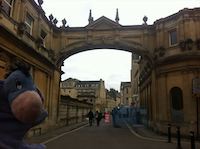
|
|
Have a look at the large stone plaque. Which century is mentioned? Let this be A.
A – __ (odd number)
⇒ Cache suggestion: Hot Springs, Bath (Earth Cache GC185X3). This Earth Cache was placed in 2007 by The Wombles.
|
STAGE 2: The Grand Pump Room
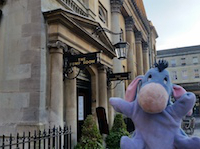 |
Bath is well known for its hot springs. Drinking the spa water is supposed to help with all kinds of ailments. In the Grand Pump Room, visitors can drink the curing water from a marble vase for a small charge. Today, the Pump Room is an elegant restaurant that serves stylish breakfasts, lunches and afternoon teas. The original Pump Room was built in 1706 but was later demolished to make way for the present building dating back to 1799. It used to be a meeting point for fashionable people and was well known and frequented by author Jane Austen.
|
|
Have a look at the signs and plaques to the left of the entrance to the pump room. The well-known novel F… was written here. What is the name of the author? Count the letters of her married surname only and let this be B.
B – __ (odd number)
|
STAGE 3: Bath Abbey
| Bath Abbey is an Anglican parish church which was founded in the 7th century. It is one of the largest Perpendicular Gothic buildings in the West of England. The church is cruciform in plan, and able to seat 1200 people. Today it is an active place of worship, but also hosts secular civic ceremonies, concerts and lectures. The sitting bishop of the local diocese resides in the city of Wells. |
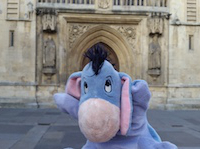
|
|
There is a big circular stone plaque on the ground a few metres in front of the main Abbey door. How many golden acorns are there in the centre of it?
C – __ (odd number)
⇒ Cache suggestion: Find the clues for Church Micro 7500...Bath Abbey (Multi Cache GC5PM00). This Church Micro Multi Cache was placed in 2015 by Austin The Archivist.
|
STAGE 4: Rebecca Fountain
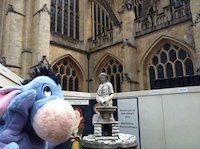 |
Rebecca Fountain is on the north side of Bath Abbey. It is a historic marble drinking fountain that was erected by the Bath Temperance Association in 1861. It holds two inscriptions that aimed at encouraging people to drink water at a time where many people drank too much alcohol.
|
|
At the back of the fountain, there is a date engraved in the stone: “Month 8th 1861” Which number month is it?
D – __
⇒ Cache suggestion: Rebecca (Earth Cache GC86B6V). This Earth Cache was placed in 2019 by Angelou666.
|
STAGE 5: Parade Gardens
| Parade Gardens used to be popular pleasure gardens in the 18th and 19th century. Today’s park was laid out in the 1930s. It is a wonderful place which you can access for a small entry fee. Come here to relax and pass the time of day. |
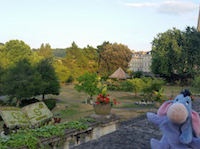
|
|
To the right of the entrance gate there is a black lamp pillar. Which green numbers are visible? Take the check sum to get E.
E – __ (odd number)
⇒ Cache suggestion: The First King of England (Bath) (Virtual Cache GC2AA48). This Virtual Cache was placed in 2002 by The Wombles.
|
STAGE 6: Sally Lunn’s
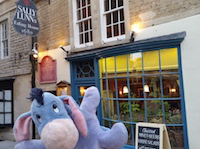 |
One of the oldest buildings in Bath houses the tea and eating house Sally Lunn’s. A Sally Lunn or Bath Bun is a tea cake which is similar to French brioche. It is a regional speciality that has become popular outside the city boundaries of Bath. It is said that the French Huguenot refugee Solange Luyon brought the recipe for this bun to Bath in the 1680s. When visiting Sally Lunn’s today, you can have breakfasts, lunches or afternoon teas here and visit the kitchen museum, which shows the actual kitchen used in Georgian Bath to create the first Bath Bun.
|
|
There is a bronze plaque on the floor right in front of the door with a two-digit number right in the middle. Let the first digit be F.
F – __ (odd number)
|
STAGE 7: Abbey Green
|
Abbey green is a pleasant little square in between Georgian houses south of Bath Abbey. The ancient Plane Tree in the centre of the square is very impressive and over 200 years old. It is known as the Hanging Tree and said to be the place where public executions took place a long time ago.
|
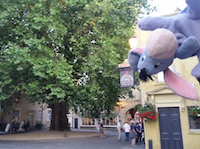
|
|
How many stone bollards surround the tree? (even number)
Alternative question if the stone bollards are missing: How many windows are there above at Cafe Pastel? (even number)
G – __ (even number)
⇒ Cache suggestion: Abbey Green (Traditional Cache GC2AA48). This Traditional Cache was placed in 2010 by Mr Elusive.
|
STAGE 8: Bath Spa Railway Station
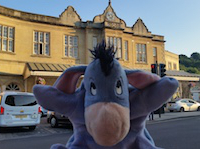 |
Bath Spa Railway Station was built in 1840 by Isambard Kingdom Brunel. Great Western train services link this station to other cities such as Bristol, Chippenham and London.
|
|
To the left of the main entrance, there is a red circular plaque. How many “Ts” are there in the words in the outer circle?
H – __ (even number)
⇒ Cache suggestion: SideTracked - Bath Spa Revisited (Traditional Cache GC33VMN).
|
STAGE 9: Green Park Station
|
Green Park Station is a former station in Bath which is no longer operational. It was opened in 1870. Following a reduction in route networks in the 1960s, Green Park Station became redundant and was closed. It was derelict for about 10 years until a supermarket chain resurrected the station and restored the building. Today it is a buzzing covered market, but you can still envisage the old train station.
|
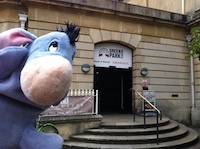 |
|
To the left of the entrance to Green Park Station, there is a red circular plaque. How long was the railway line mentioned? Take the check sum.
I – __ (odd number)
|
STAGE 10: Herschel Museum
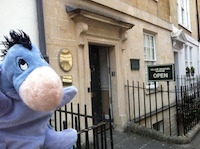 |
In 1871 German-born British astronomer William Herschel discovered the planet Uranus, whilst he was observing space from the garden of his house. The house itself is a small townhouse built in the 1760s. Today it is a museum which was opened in 1981 and which shows how William Herschel and his sister Caroline lived there at the time.
|
|
To the left of the entrance there are two golden signs. Underneath someone has etched four capital letters into the Bath stone. Look at the first letter. What is its position in the alphabet.
J – __ (odd number)
|
Well done! You've made it half-way. Now add up your numbers for A-J: The sum should be 55.
If this is correct, you may continue to stage 11.
STAGE 11: Theatre Royal
Opened in 1805, this is one of Britain’s oldest working theatres. There are different performances and events at the theatre all year round and it has a capacity for an audience of around 900. In 1862 the theatre was destroyed by a fire but rebuilt and reopened only a year later. It is said to have a phantom doorman, so watch out whilst you are in the area.
 |
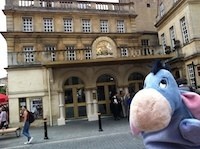
|
|
Looking at the main entrance, there is a black plaque to the right. How many people are mentioned on this plaque?
K – __ (odd number)
|
STAGE 12: Queen Square
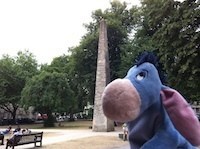 |
Queen Square is named in honour of Queen Caroline (1683-1737). Famous English architect John Wood, the Elder designed the square in the early 18th century.
After its completion Queen Square was a popular residence for Bath's Georgian society as it was away from the crowded streets of medieval Bath but only a short walk to the Abbey, Pump Room, Assembly Rooms and baths.
Today, the square hosts many attractions all year, such as a French market, Italian market and Boules weekends.
|
|
Have a look at the stone plaque on the obelisk. On this side of the obelisk, how many stones are there in the second row from the bottom?
L – __ (odd number)
⇒ Cache suggestion: Queen Square 2 (Multi Cache GC2RXHW). This Multi Cache was placed in 2011 by Jenny&James.
|
STAGE 13: Jane Austen Centre
|
Famous English novelist, Jane Austen, lived in Bath from 1801 to 1806. Jane Austen experienced a classy yet vibrant city, which inspired her to write two of her six published novels, Northanger Abbey and Persuasion.
The Jane Austen Centre celebrates the author’s time in Bath. When the centre is open, it is very likely you will be greeted by Bath’s most photographed man: Martin, stands outside the centre with a white beard dressed in full Regency garb, waving to motorists and passers-by. He talks to people and if you ask, you can have your picture taken with him. He may also point you to the next stage of this multi cache: the pavilion at Victoria Park.
|
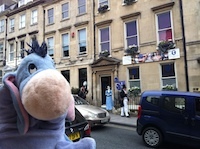 |
|
When standing in front of the Jane Austen Centre, look at the entrance of the building to the right. Which golden numbers are there above the entrance? You need the first number: M1
M – __ (even number)
|
STAGE 14: Royal Victoria Park
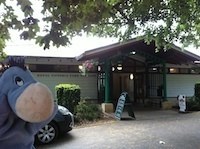 |
Princess Victoria opened this park in 1830 when she was only 11 years old. Seven years later, she became Queen of England.Today, the park consists of 57 acres (231,000 m⊃2;) and is overlooked by the Royal Crescent. It offers a variety of leisure activities such as a large children’s play area, a crazy golf course, a skateboard ramp, tennis courts, a golf course and a boating pond. One of the most delightful features of Royal Victoria Park is the Botanical Gardens with a great variety of different plants and a replica of a Roman Temple.
|
|
As you exit the Royal Victoria Park Pavilion, look at the tree on the left. There is a little silver plaque on it with five lines. The first line says "Tiliaceae". Which continent is mentioned in the last line of this plaque?
Asia: N = 2
Australia: N = 1
Europe: N = 0
N – __
|
STAGE 15: Royal Crescent
|
The Royal Crescent, built between 1767 and 1775, was designed by John Wood the Younger. It is a row of 30 grand Georgian townhouses arranged around a perfect lawn overlooking Royal Victoria Park. Many notable people have either lived or stayed in the Royal Crescent since it was built, and some are commemorated on special plaques attached to the relevant buildings.
Apart from being a residential building, the Royal Crescent is home to the five-star hotel and the No. 1 Royal Crescent museum.
|
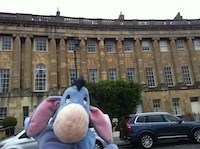 |
|
Opposite the Royal Crescent Hotel (house number 16), there is a little plaque under the handrail of the fence The first line on this plaque reads "The Royal Crescent". What is the check sum of the year mentioned in the second line of this plaque?
O – __ (odd number)
⇒ Cache suggestion: Royal Crescent (Bath, NE Somerset) (Traditional Cache GC5BFE). This Traditional Cache was placed in 2002 by The Wombles.
|
STAGE 16: The Circus
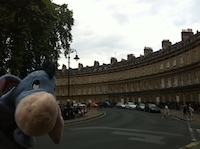 |
The Circus is a row of large townhouses forming a circle with three entrances. John Wood, the Elder designed the Circus in 1754. The name comes from the Latin 'circus', which means a ring, oval or circle. If you look a little closer at the detail on the stonework and you’ll see many different emblems, such as serpents, acorns or nautical symbols. When you are at the Circus, make sure you stand right in the middle of it. On the one hand, this is a great spot to marvel at this inspiring and beautiful piece of architecture but on the other hand you can try to find the exact spot where anything you say will echo!
|
|
There is a square stone in the centre in between the trees. There is room for how many little squares on this stone?
3 squares: P = 6
9 squares: P = 4
16 squares: P = 2
P – __
⇒ Cache suggestion: The Circus (Virtual Cache GC88ZJA). This Virtual Cache was placed in July 2020 by Jenny&James.
⇒ Adventure lab cache suggestion: Beautiful Bath - 3. Circus.
|
STAGE 17: Assembly Rooms and Fashion Museum
|
The Bath Assembly Rooms were designed by John Wood, the Younger in 1769. Being at the centre of the social scene, they were used for dancing, card playing, tea drinking and conversation. Today the rooms are still used for functions and conferences. They are also home to the world-famous Fashion Museum which focuses on fashionable dress for men, women and children from the late 16th century to the present day. It has more than 100,000 objects. The earliest pieces are embroidered shirts and gloves from about 1600. You can also visit a cafe and a gift shop here.
|
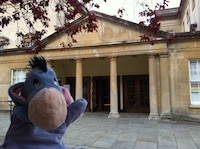 |
|
Have a look around. There is a red phone booth nearby and a parking meter next to it. What is the location number of the ticket machine? Q51045. Find the number for Q.
Q – __ (odd number)
The number appears to be missing. Until we've got time to check it out, here is an additional hint. The number is not 1,3,5, or 9.
⇒ Adventure lab cache suggestion: If you do a little detour on your way to stage 18, you can look for the two adventure lab caches: Beautiful Bath - 1. Milsom street poem and 4. Rudge&Freese-Greene.
|
STAGE 18: Bath Postal Museum
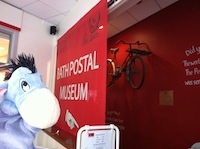 |
The first recorded posting of a Penny Black took place at the main post office in Bath. Bath Postal Museum, founded in 1979, is located in the basement of the post office building. At the museum you can find out about the history of the post from 2000 BC to the present and also the history of the British postbox.
⇒ Adventure lab cache suggestion: If you do a little detour on your way to stage 19, you can look for the adventure lab cache: Beautiful Bath - 2. Walcot Wall.
|
|
There is a plaque to the left of the entrance to the post office. Which year is on the postmark? Take the single-digit check sum.
R – __ (even number)
|
STAGE 19: Pulteney Bridge
|
Pulteney Bridge is one of only four bridges in the world to have shops across its full span on both sides. The shops are small and the roadway is not wide but when the bridge opened in 1770, it was a revelation. Today it is surely one of the world's most beautiful and romantic bridges, best viewed from Parade Gardens and the crescent weir.
|
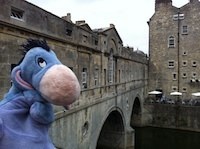 |
|
As you approach Pulteney Bridge, have a look at the black plaque which is at the back of the first shop on the right-hand side (above/behind the street sign “Grand Parade”). Count the letters of the job mentioned on the plaque.
S – __ (odd number)
⇒ Cache suggestion: Pulteney Weir (Traditional Cache GC4M55W). This Traditional Cache was placed in 2013 by Gowenhouse.
⇒ Adventure lab cache suggestion: On your way to stage 19, you can look for the adventure lab cache: Beautiful Bath - 5. Fantastic Fake Windows.
|
STAGE 20: Laura Place
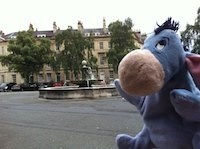 |
Laura Place is a set of four blocks of houses built around an irregular quadrangle at the end of Pulteney Bridge. It was built between 1788 and 1794. Laura fountain is in the centre of the square.
|
|
Look at the little plaque on the fountain mentioning its restauration. Count the points of the star on this plaque.
T – __
|
Well done! You've completed all 20 stages of this multi cache. Now add up your numbers for K-T: The sum should be 45.
If you haven't added them up already, the sum of your numbers for A-J should be 55.
You may now make your way to the final stage, where the cache is located. The final location is at:
N 51° (T-G)(D-O).(R-F)(E-M)(K-A)'
W 002° (B-L)(C+N).(J-Q)(I-S)(H-P)'
If you are unsure if your coordinates are correct, you can use this geochecker:

Happy caching!
Well done to TheOldfields for being the FIRST TO FIND their way around the Guided Tour of Bath City!
Updates:
05/01/2019: Stage 7 - The stone bollards have been removed. New question added.
22/04/2019: Stage 7 - The stone bollards are back so let's revert to the original question.
22/04/2019: Stage 17 - The telephone has been removed from the phone booth. New question added.
03/01/2020: Suggestions for Adventure Lab Caches have been added.
10/07/2020: Stage 16 - Cache suggestion for The Circus was updated. The original Mystery Cache has been replaced by a Virtual Cache.